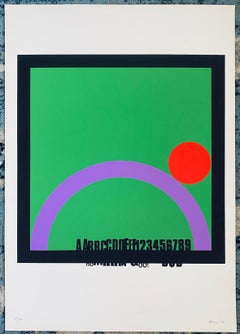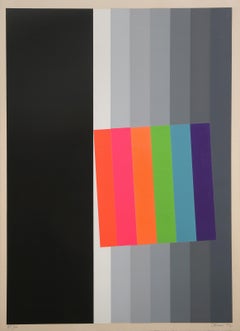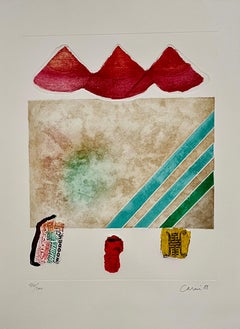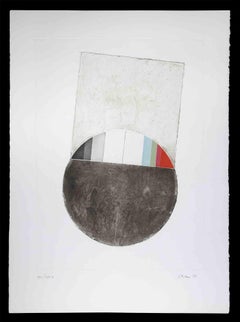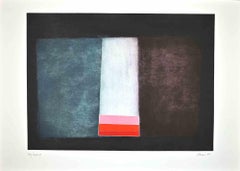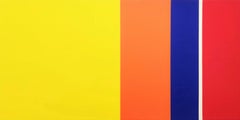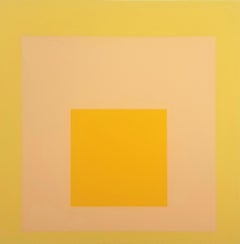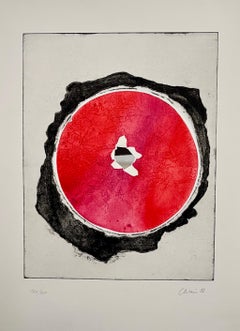Eugenio Carmi Abstract Prints
Italian, 1920-1977
Eugenio Carmi was born in 1920 in Genoa, Italy. At age fifteen he began painting lessons, which came to a halt during the Second World War during which he graduated with a degree in chemistry from Swiss Federal Institute of Technology. In 1946, Carmi was living in Italy and became a student of the painter Felice Casorati, whose work remained an inspiration for his own in the next decade.
In the late 1950s, Carmi was tasked with promoting Cornigliano Steelworks and used steel and iron to create contemporary art to enhance the company’s image. This led to his first solo exhibition in 1958 at the Galleria Numero in Florence, where he presented enamel paintings on steel. During the 1960s and 1970s, Carmi focused on creating work inspired by the combination of industry and culture, leading to lithographs on tin plates and linking kinetic and audiovisual art. It was in the 1970s that he developed his signature geometric style, a contrast from the Art Informel style of the previous decades. He often used mathematical laws such as the Pythagoras theorem to create his precise geometric shapes, a nod to his training at the Swiss Federal Institute of Technology.to
10
Overall Width
to
Overall Height
to
4
1
13
636
205
165
164
10
1
9
8
2
8
5
2
7
3
Artist: Eugenio Carmi
Italian Artist Modern Silkscreen Eugenio Carmi
By Eugenio Carmi
Located in Surfside, FL
Eugenio Carmi is an Italian painter born in 1920 in Genoa. He studied in Turin in Felice Casorati’s studio. His experience as a graphic designer in the ‘50s, is decisive for his pict...
Category
1980s Modern Eugenio Carmi Abstract Prints
Materials
Screen
Realite Imaginaire, Abstract Geometric Screenprint by Eugenio Carmi
By Eugenio Carmi
Located in Long Island City, NY
Eugenio Carmi, Italian (1920 - 2016) - Realite Imaginaire, Year: 1972, Medium: Screenprint on Arches, signed, dated and numbered in pencil, Edition: 85/100, Image Size: 28.5 x 20...
Category
1970s Abstract Geometric Eugenio Carmi Abstract Prints
Materials
Screen
Italian Abstract Aquatint Collage Lithograph Print Eugenio Carmi 80s Memphis Era
By Eugenio Carmi
Located in Surfside, FL
Genre: Modern, Modernist
Subject: Abstract
Medium: Print, Aquatint
Hand signed dated 1988, limited edition
Surface: Paper
Country: Italy
Dimensions: 26" x 20" approximately
Eugenio ...
Category
1980s Post-Modern Eugenio Carmi Abstract Prints
Materials
Aquatint
Abstract Composition - Etching by Eugenio Carmi - 1987
By Eugenio Carmi
Located in Roma, IT
Abstract Composition is an original etching realized by Eugenio Carmi in 1987.
Good conditions
Numbered. Edition, VIII/XXXV.
The artwork is depicted in a well-balanced composition.
Category
1980s Abstract Eugenio Carmi Abstract Prints
Materials
Etching
Abstract Composition - Etching by Eugenio Carmi - 1987
By Eugenio Carmi
Located in Roma, IT
Abstract Compositionis an original etching made by Eugenio Carmi (Genoa, 1920 - Lugano, 2016) in 1987.
Good conditions.
Hand signed and numbered. Edition, VIII/XXXV.
Eugenio Carmi...
Category
1980s Abstract Eugenio Carmi Abstract Prints
Materials
Etching
Abstract Composition - Etching by Eugenio Carmi - 1987
By Eugenio Carmi
Located in Roma, IT
Abstract Composition is an original etching made by Eugenio Carmi (Genoa, 1920 - Lugano, 2016) in 1987.
Good conditions.
Hand signed and numbered. Edition, VIII/XXXV.
Eugenio Carm...
Category
1980s Abstract Eugenio Carmi Abstract Prints
Materials
Etching
Italian Abstract Aquatint Collage Lithograph Print Eugenio Carmi 80s Memphis Era
By Eugenio Carmi
Located in Surfside, FL
Genre: Modern, Modernist
Subject: Abstract
Medium: Print, Aquatint
Hand signed dated 1988, limited edition
Surface: Paper
Country: Italy
Dimensions: 26" x 20" approximately
Eugenio ...
Category
1980s Post-Modern Eugenio Carmi Abstract Prints
Materials
Aquatint
Italian Abstract Aquatint Collage Lithograph Print Eugenio Carmi 80s Memphis Era
By Eugenio Carmi
Located in Surfside, FL
Genre: Modern, Modernist
Subject: Abstract
Medium: Print, Aquatint
Hand signed dated 1988, limited edition
Surface: Paper
Country: Italy
Dimensions: 26" x 20" approximately
Eugenio ...
Category
1980s Post-Modern Eugenio Carmi Abstract Prints
Materials
Aquatint
Italian Abstract Aquatint Collage Lithograph Print Eugenio Carmi 80s Memphis Era
By Eugenio Carmi
Located in Surfside, FL
Genre: Modern, Modernist
Subject: Abstract
Medium: Print, Aquatint with metal foil
Hand signed dated 1988, limited edition
Surface: Paper
Country: Italy
Dimensions: 26" x 20" approxi...
Category
1980s Post-Modern Eugenio Carmi Abstract Prints
Materials
Aquatint
Italian Abstract Aquatint Collage Lithograph Print Eugenio Carmi 80s Memphis Era
By Eugenio Carmi
Located in Surfside, FL
Genre: Modern, Modernist
Subject: Abstract
Medium: Print, Aquatint with metal foil
Hand signed dated 1988, limited edition
Surface: Paper
Country: Italy
Dimensions: 26" x 20" approxi...
Category
1980s Post-Modern Eugenio Carmi Abstract Prints
Materials
Aquatint
Related Items
Grove #1 /// Abstract Geometric Colorful Jay Rosenbulm New York Screenprint Art
By Jay Rosenblum
Located in Saint Augustine, FL
Artist: Jay Rosenblum (Americam, 1933-1989)
Title: "Grove #1"
*Signed by Rosenblum in pencil lower right
Year: 1979
Medium: Original Screenprint on white Stonehenge paper
Limited edi...
Category
1970s Abstract Geometric Eugenio Carmi Abstract Prints
Materials
Screen
$900
H 24.63 in W 42.38 in
Arrived /// Bauhaus Abstract Geometric Josef Albers Screenprint Yellow Minimal
By Josef Albers
Located in Saint Augustine, FL
Artist: Josef Albers (German-American, 1888-1976)
Title: "Arrived"
Portfolio: Soft Edge - Hard Edge
*Signed and dated by Albers in pencil lower right
...
Category
1960s Abstract Geometric Eugenio Carmi Abstract Prints
Materials
Screen
Variant I /// Josef Albers Abstract Geometric Screenprint Minimalism Bauhaus Art
By Josef Albers
Located in Saint Augustine, FL
Artist: Josef Albers (German-American, 1888-1976)
Title: "Variant I"
Portfolio: Ten Variants
*Unsigned edition
Year: 1967
Medium: Original Screenprint on Rives BFK paper
Limited edit...
Category
1960s Abstract Geometric Eugenio Carmi Abstract Prints
Materials
Screen
Presenza Grafica
By Alexander Calder
Located in New York, NY
Large, scarce limited edition color aquatint by Alexander Calder, from a limited edition of 90. Signed by Calder and numbered in pencil. Printed and published by 2RC Edizioni d'Art...
Category
1970s Abstract Eugenio Carmi Abstract Prints
Materials
Aquatint
JHM - II /// Bauhaus Abstract Geometric Josef Albers Screenprint Minimalism
By Josef Albers
Located in Saint Augustine, FL
Artist: Josef Albers (German-American, 1888-1976)
Title: "JHM - II"
Portfolio: Josef Albers Honors the Hirshhorn Museum and Sculpture Garden
*Monogram signed and dated by Albers in p...
Category
1970s Abstract Geometric Eugenio Carmi Abstract Prints
Materials
Screen
$15,000
H 26.5 in W 36.63 in
Variant II /// Josef Albers Abstract Geometric Screenprint Minimalism Bauhaus
By Josef Albers
Located in Saint Augustine, FL
Artist: Josef Albers (German-American, 1888-1976)
Title: "Variant II"
Portfolio: Ten Variants
*Unsigned edition
Year: 1967
Medium: Original Screenprint on Rives BFK paper
Limited edi...
Category
1960s Abstract Geometric Eugenio Carmi Abstract Prints
Materials
Screen
Fil du Temps
By Etel Adnan
Located in London, GB
Etel Adnan "Fil du Temps" 2021. Etching on wove paper. Edition of 100.
A critical work by Adnan, the final etching in this series. Etel was unable to put pencil to paper due to her ...
Category
2010s Abstract Impressionist Eugenio Carmi Abstract Prints
Materials
Etching
"Nude"
By Auguste Herbin
Located in Astoria, NY
Auguste Herbin (French, 1882-1960), "Nude", Geoemtric Composition, Serigraph on Paper, 1960, numbered edition "145/150" lower left, apparently unsigned, silver-tone frame. 19.25" H x...
Category
1960s Modern Eugenio Carmi Abstract Prints
Materials
Paper, Screen
"Lincoln Center" by Sol Lewitt
By Sol LeWitt
Located in Hinsdale, IL
SOL LEWITT
(1928 – 2007)
Lincoln Center
Color screenprint on Somerset Satin White,1998.
Sheet size: 35 1/2x28 inches, full margins.
Signed and numbered 73/108 in pencil, lower ri...
Category
1990s Abstract Geometric Eugenio Carmi Abstract Prints
Materials
Screen
Les Oiseaux De Feu
By Lars Bo
Located in Llanbrynmair, GB
’Les Oiseaux De Feu’
By Lars Bo
Medium - Etching on BFK Rives paper
Signed - Yes
Edition - 61/120
Date - 1964
Size - 650mm x 500mm
Condition - 9
Colour of print may not be ac...
Category
1960s Abstract Eugenio Carmi Abstract Prints
Materials
Etching
Arctic Bloom /// Josef Albers Blue Orange Screenprint Homage to the Square Print
By Josef Albers
Located in Saint Augustine, FL
Artist: Josef Albers (German-American, 1888-1976)
Title: "Arctic Bloom"
Portfolio: Soft Edge - Hard Edge
*Unsigned edition, (there was also a signed edition of 50 on Rives BFK paper)...
Category
1960s Abstract Geometric Eugenio Carmi Abstract Prints
Materials
Screen
$6,000
H 16.94 in W 16.94 in
Coleman Pond III
By Alex Katz
Located in Miami, FL
Alex Katz (b. 1927)
Coleman Pond III (Bauer 446)
Heliorelief woodcut on tosa washi hanga natural paper
Signed and numbered “Pres 1/6” in the lower margin. Printed by Tom Pruitt, G...
Category
21st Century and Contemporary Abstract Eugenio Carmi Abstract Prints
Materials
Etching, Woodcut
Previously Available Items
Italian Abstract Aquatint Collage Lithograph Print Eugenio Carmi 80s Memphis Era
By Eugenio Carmi
Located in Surfside, FL
Genre: Modern, Modernist
Subject: Abstract
Medium: Print, Aquatint
Hand signed dated 1988, limited edition
Surface: Paper
Country: Italy
Dimensions: 26" x 20" approximately
Eugenio ...
Category
1980s Post-Modern Eugenio Carmi Abstract Prints
Materials
Aquatint
Italian Artist Modern Silkscreen Eugenio Carmi
By Eugenio Carmi
Located in Surfside, FL
Eugenio Carmi is an Italian painter born in 1920 in Genoa. He studied in Turin in Felice Casorati’s studio. His experience as a graphic designer in the ‘50s, is decisive for his pictorial research, based on a rigorous geometrical structure and on a fine analysis of the perception of colors.
He participated in the Venice Biennale in 1966.
In 1967 he showed some electronic works in the Superlund exhibition organized by Pierre Restany in Lund, Sweden.
In 1968, he introduced the “Carm-o-matic”, during the Cybernetic Serendipity show at the Institute of Contemporary Art in London.
In 1973, he produced an entirely abstract 25-minute show for RAI’s Experimental Programs Service. The same year, he taught visual art seminars at the Rhode Island Institute of Design in the United States.
In the ‘70s, he gave courses at the Accademia of Macerata and at the Accademia of Ravenna (Italy).
He produced illustrations for three of Umberto Eco’s stories, published in Italy by Bompiani and in many other countries. The French Ministry of Education has selected them for libraries and schools in France.
The most important retrospective of his work was organized by the Milan town hall in 1990, followed by a prestigious exhibition in Budapest, in the halls of the Royal Palace, in 1992.
In 1991 he exhibited at the San Francisco Italian American Museum.
In 1996 the “Carmi” book is published by Umberto Eco and Duncan Macmillan and presented at the Milan Triennial: a synthesis of his life.
From 1957 to 1965 he will play the role of artistic director of Cornigliano's corporate magazine.
During this time iron and steel are materials that Carmi meets every day and become a strong creative stimulus for him. In his first solo exhibition - presented by Gillo Dorfles in 1958 at the Galleria Numero di Firenze - the protagonists are the enamels on steel and since 1960 he made various iron and steel works welded and lithographed milk.
Iron and steel is the work that in 1962 presented at Spoleto Sculpture exhibition in the city , organized by Giovanni Carandente under the V Festival of the Two Worlds .
In this period, he is involved not only in the cultural politics of the Istallier ( Victor Vasarely , Umberto Eco , Max Bill , Konrad Wachsmann , Furio Colombo , Ugo Mulas , Kurt Blum , Emanuele Luzzati , Flavio Costantini ) , But also in the cultural activity of the Warehouse Gallery , which Carmi founded in Boccadasse in 1963. The Warehouse Gallery with multiples intends to propose a serial art accessible to a wider audience and is placed in international discussions on 'Multiplied Art, representing one of the most important examples.
The friendship and mutual esteem that binds him to Umberto Eco has two very important fruits at this time: Children's Fables and Stripsody . In 1966 for the publishing house Bompiani came three Eco fables illustrated by Carmi and then re-introduced in 1988 with new Carmi illustrations and a fable more. Stripsody is a musical project on cartoon sound, designed and then interpreted by the genius singer Cathy Berberian, with Eco texts and illustrations by Carmi.
Eugenio Carmi, who is always fascinated by the new technological possibilities in the 1960s and 1970s, is the author of experimental cinematic and audiovisual artwork and also realizes those who will call electrical imagery signals that will also be at the center of a provocative installation on the streets of the city of Caorle .
It is at this stage that in 1966 he was at the XXXIII edition of the Venice Biennale with the electronic work SPCE (electronically controlled polycyclic structure), which is also the invitation of Pierre Restany to participate with electronic works at the SuperLund exhibition in Sweden.
In 1971, he moved to Milan with his family, where he established his study.
At this point, though with incursions in other parallel fields such as the realization of mirrors and stained glass, painting, and sporadically sculpture - which had approached the Istal period - is at the center of its activity. It is at the beginning of the seventies that it deepens the geometric language, already open with some previous experiences (accident prevention signs for the Italsider, some multiples for the Deposit and electrical imagery signals), replacing it with the informal one.
In 1979 he produced a magazine - which will remain the same number - by the name of Res Publica , for which he receives the contributions of intellectuals and artists, including Umberto Eco, Antonio Porta , Gillo Dorfles , Richard Paul Lohse...
Category
1980s Modern Eugenio Carmi Abstract Prints
Materials
Screen
Abstract Composition Aquatint collage
By Eugenio Carmi
Located in Surfside, FL
Genre: Modern
Subject: Abstract
Medium: Print, Aquatint
Surface: Paper
Country: United States
Dimensions w/Frame: 26" x 19"
Eugenio Carmi is an Italian painter born in 1920 in Genoa. He studied in Turin in Felice Casorati’s studio. His experience as a graphic designer in the ‘50s, is decisive for his pictorial research, based on a rigorous geometrical structure and on a fine analysis of the perception of colors.
He participated in the Venice Biennale in 1966.
In 1967 he showed some electronic works in the Superlund exhibition organized by Pierre Restany in Lund, Sweden.
In 1968, he introduced the “Carm-o-matic”, during the Cybernetic Serendipity show at the Institute of Contemporary Art in London.
In 1973, he produced an entirely abstract 25-minute show for RAI’s Experimental Programs Service. The same year, he taught visual art seminars at the Rhode Island Institute of Design in the United States.
In the ‘70s, he gave courses at the Accademia of Macerata and at the Accademia of Ravenna (Italy).
He produced illustrations for three of Umberto Eco’s stories, published in Italy by Bompiani and in many other countries. The French Ministry of Education has selected them for libraries and schools in France.
The most important retrospective of his work was organized by the Milan town hall in 1990, followed by a prestigious exhibition in Budapest, in the halls of the Royal Palace, in 1992.
In 1991 he exhibited at the San Francisco Italian American Museum.
In 1996 the “Carmi” book is published by Umberto Eco and Duncan Macmillan and presented at the Milan Triennial: a synthesis of his life.
From 1957 to 1965 he will play the role of artistic director of Cornigliano's corporate magazine.
During this time iron and steel are materials that Carmi meets every day and become a strong creative stimulus for him. In his first solo exhibition - presented by Gillo Dorfles in 1958 at the Galleria Numero di Firenze - the protagonists are the enamels on steel and since 1960 he made various iron and steel works welded and lithographed milk.
Iron and steel is the work that in 1962 presented at Spoleto Sculpture exhibition in the city , organized by Giovanni Carandente under the V Festival of the Two Worlds .
In this period, he is involved not only in the cultural politics of the Istallier ( Victor Vasarely , Umberto Eco , Max Bill , Konrad Wachsmann , Furio Colombo , Ugo Mulas , Kurt Blum , Emanuele Luzzati , Flavio Costantini ) , But also in the cultural activity of the Warehouse Gallery , which Carmi founded in Boccadasse in 1963. The Warehouse Gallery with multiples intends to propose a serial art accessible to a wider audience and is placed in international discussions on 'Multiplied Art, representing one of the most important examples.
The friendship and mutual esteem that binds him to Umberto Eco has two very important fruits at this time: Children's Fables and Stripsody . In 1966 for the publishing house Bompiani came three Eco fables illustrated by Carmi and then re-introduced in 1988 with new Carmi illustrations and a fable more. Stripsody is a musical project on cartoon sound, designed and then interpreted by the genius singer Cathy Berberian, with Eco texts and illustrations by Carmi.
Eugenio Carmi, who is always fascinated by the new technological possibilities in the 1960s and 1970s, is the author of experimental cinematic and audiovisual artwork and also realizes those who will call electrical imagery signals that will also be at the center of a provocative installation on the streets of the city of Caorle .
It is at this stage that in 1966 he was at the XXXIII edition of the Venice Biennale with the electronic work SPCE (electronically controlled polycyclic structure), which is also the invitation of Pierre Restany to participate with electronic works at the SuperLund exhibition in Sweden.
In 1971, he moved to Milan with his family, where he established his study.
At this point, though with incursions in other parallel fields such as the realization of mirrors and stained glass, painting, and sporadically sculpture - which had approached the Istal period - is at the center of its activity. It is at the beginning of the seventies that it deepens the geometric language, already open with some previous experiences (accident prevention signs for the Italsider, some multiples for the Deposit and electrical imagery signals), replacing it with the informal one.
In 1979 he produced a magazine - which will remain the same number - by the name of Res Publica , for which he receives the contributions of intellectuals and artists, including Umberto Eco, Antonio Porta , Gillo Dorfles , Richard Paul Lohse...
Category
1980s Eugenio Carmi Abstract Prints
Materials
Aquatint
Abstract Composition
By Eugenio Carmi
Located in Surfside, FL
Genre: Modern
Subject: Abstract
Medium: Print, Aquatint
Surface: Paper
Country: United States
Dimensions w/Frame: 26" x 19"
Eugenio Carmi is an Italian painter born in 1920 in Genoa. He studied in Turin in Felice Casorati’s studio. His experience as a graphic designer in the ‘50s, is decisive for his pictorial research, based on a rigorous geometrical structure and on a fine analysis of the perception of colors.
He participated in the Venice Biennale in 1966.
In 1967 he showed some electronic works in the Superlund exhibition organized by Pierre Restany in Lund, Sweden.
In 1968, he introduced the “Carm-o-matic”, during the Cybernetic Serendipity show at the Institute of Contemporary Art in London.
In 1973, he produced an entirely abstract 25-minute show for RAI’s Experimental Programs Service. The same year, he taught visual art seminars at the Rhode Island Institute of Design in the United States.
In the ‘70s, he gave courses at the Accademia of Macerata and at the Accademia of Ravenna (Italy).
He produced illustrations for three of Umberto Eco’s stories, published in Italy by Bompiani and in many other countries. The French Ministry of Education has selected them for libraries and schools in France.
The most important retrospective of his work was organized by the Milan town hall in 1990, followed by a prestigious exhibition in Budapest, in the halls of the Royal Palace, in 1992.
In 1991 he exhibited at the San Francisco Italian American Museum.
In 1996 the “Carmi” book is published by Umberto Eco and Duncan Macmillan and presented at the Milan Triennial: a synthesis of his life.
From 1957 to 1965 he will play the role of artistic director of Cornigliano's corporate magazine.
During this time iron and steel are materials that Carmi meets every day and become a strong creative stimulus for him. In his first solo exhibition - presented by Gillo Dorfles in 1958 at the Galleria Numero di Firenze - the protagonists are the enamels on steel and since 1960 he made various iron and steel works welded and lithographed milk.
Iron and steel is the work that in 1962 presented at Spoleto Sculpture exhibition in the city , organized by Giovanni Carandente under the V Festival of the Two Worlds .
In this period, he is involved not only in the cultural politics of the Istallier ( Victor Vasarely , Umberto Eco , Max Bill , Konrad Wachsmann , Furio Colombo , Ugo Mulas , Kurt Blum , Emanuele Luzzati , Flavio Costantini ) , But also in the cultural activity of the Warehouse Gallery , which Carmi founded in Boccadasse in 1963. The Warehouse Gallery with multiples intends to propose a serial art accessible to a wider audience and is placed in international discussions on 'Multiplied Art, representing one of the most important examples.
The friendship and mutual esteem that binds him to Umberto Eco has two very important fruits at this time: Children's Fables and Stripsody . In 1966 for the publishing house Bompiani came three Eco fables illustrated by Carmi and then re-introduced in 1988 with new Carmi illustrations and a fable more. Stripsody is a musical project on cartoon sound, designed and then interpreted by the genius singer Cathy Berberian, with Eco texts and illustrations by Carmi.
Eugenio Carmi, who is always fascinated by the new technological possibilities in the 1960s and 1970s, is the author of experimental cinematic and audiovisual artwork and also realizes those who will call electrical imagery signals that will also be at the center of a provocative installation on the streets of the city of Caorle .
It is at this stage that in 1966 he was at the XXXIII edition of the Venice Biennale with the electronic work SPCE (electronically controlled polycyclic structure), which is also the invitation of Pierre Restany to participate with electronic works at the SuperLund exhibition in Sweden.
In 1971, he moved to Milan with his family, where he established his study.
At this point, though with incursions in other parallel fields such as the realization of mirrors and stained glass, painting, and sporadically sculpture - which had approached the Istal period - is at the center of its activity. It is at the beginning of the seventies that it deepens the geometric language, already open with some previous experiences (accident prevention signs for the Italsider, some multiples for the Deposit and electrical imagery signals), replacing it with the informal one.
In 1979 he produced a magazine - which will remain the same number - by the name of Res Publica , for which he receives the contributions of intellectuals and artists, including Umberto Eco, Antonio Porta , Gillo Dorfles , Richard Paul Lohse...
Category
1980s Modern Eugenio Carmi Abstract Prints
Materials
Aquatint
Eugenio Carmi abstract prints for sale on 1stDibs.
Find a wide variety of authentic Eugenio Carmi abstract prints available for sale on 1stDibs. If you’re browsing the collection of abstract prints to introduce a pop of color in a neutral corner of your living room or bedroom, you can find work that includes elements of blue and other colors. You can also browse by medium to find art by Eugenio Carmi in etching, screen print and more. Much of the original work by this artist or collective was created during the 1980s and is mostly associated with the abstract style. Not every interior allows for large Eugenio Carmi abstract prints, so small editions measuring 20 inches across are available. Customers who are interested in this artist might also find the work of Riccardo Licata, Renato Barisani, and Fausto Melotti. Eugenio Carmi abstract prints prices can differ depending upon medium, time period and other attributes. On 1stDibs, the price for these items starts at $384 and tops out at $850, while the average work can sell for $512.
